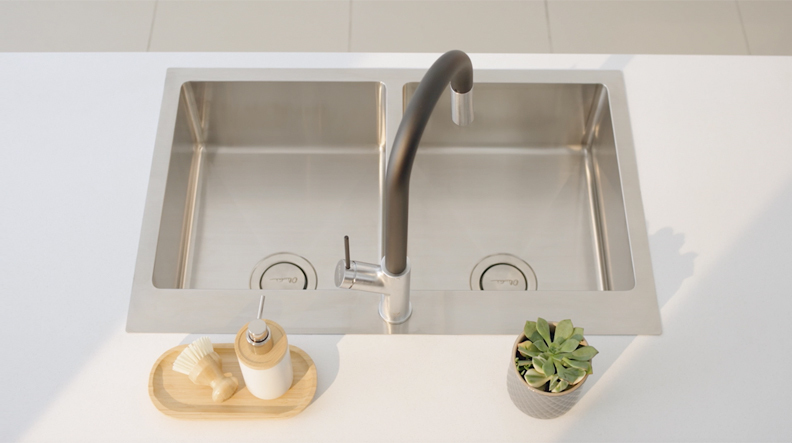
Manufactured from genuine 18/10, 304-grade stainless steel, Oliveri stainless steel sinks offer optimum hygiene and durability. For more information on the benefits of our stainless steel sinks view the video here.
It’s important to note, hardened metal utensils, food processor blades, and pots and pans will lightly scratch your sink’s surface. It’s the same for all stainless steel sinks. Over time, with wear, stainless steel sinks develop their own unique finish. Oliveri bowl protectors or dish baskets can help protect your sink’s surface.
Our sinks will continue to shine for many years by following these simple steps.

1. Rinse and dry after every use
All stainless steel surfaces are best cleaned immediately after use. Some foods, juices and chemicals can cause permanent changes to the appearance of your sink if left to sit on the surface. Rinse your sink with clean water and towel dry the surface after rinsing.

2. Complete a thorough end-of-day clean
Step two is at the end of the day, clean your sink’s surface thoroughly. Squeeze some detergent onto a soft sponge and wipe the sink in the direction of the sink’s brushing. A quick tip, avoid circular movements. You’ll be able to see the direction of the brushing if you look at the stainless steel from an angle. Rinse with water and towel dry.

3. Remove stubborn limescale
The third step, look out for a white or grey deposit on the surface. It’s most likely limescale which is easily removed. We recommend tackling it as soon as it shows up with biodegradable products, like bi-carb soda, and vinegar or lemon.This won’t harm your sink’s surface. Rinse with clean water and towel dry.

4. Once-a-month polish
Keep your sink’s gleam and keep it extra clean with a once-a-month polish. Polishing helps to seal your sink’s surface and creates a protective coating, which repels limescale and everyday grime. Polishing will help make any scratches less noticeable.
To polish, squeeze some stainless steel polish onto a soft cloth and apply in the direction of your sink’s brushing. Remember to avoid circular movements. Rinse with clean water and towel dry.
How to avoid unnecessary scratching and other surface marks
As highlighted in the video below, Oliveri stainless steel sinks are built to endure the stormy and choppy blitz of modern living, and by caring for you sink you’ll ensure its lustre will continue. Apart from the four simple steps above, here are a few more tips to keep your sink in top condition.

Use a bowl protector or drainer basket
This will help to minimise contact between your sink and hardened metal utensils like knives and food processor blades.
Always use soft cloths or sponges
Never use a plastic scourer, steel wool or a prickly brush, these will scratch the surface unnecessarily. As will harsh and agressive cleaning agents.
Do not over-polish
Concentrated polishing in one section of the sink may cause permanent changes to the appearance of the surface in that area. Only polish lightly in the direction of your sink’s brushing.
Rinse thoroughly after cleaning
If you use bleach for hygenic cleaning, be especially careful to rinse it away and dry the sink as bleach can be very aggressive.
Do not leave wet sponges on your sink
Leaving soap or wet sponges on the ledge of your sink will dull the polish and may pit the surface.
By taking all the advice above you’ll keep your sink shining, but remember over time, and with normal use, stainless steel sinks develop their own unique finish.
What causes the small marks to form on my sink’s surface?
Often these marks are limescale deposits caused by hard water. The limescale gathers dirt, making the marks visible. Small marks can also result from iron and rust particles washing from your water pipes if they are very old or galvanised, or from cast iron pans sitting in your sink. Marks can also result from bleach, salt and citric acid sitting on your sink’s surface. All marks are easy to clean with a damp, soft cloth or gentle vinegar or lemon-base cleaner. Rinse with clean water and towel dry after cleaning.
How can I stop marks forming on my sink?
Rinse your sink clean after every use, and wipe it dry with a soft cloth or towel. If a mark appears, don’t be tempted to scrub it away. Wipe it with a damp soft cloth and gentle cleaning agent or apply a stainless steel polish.
Why has my stainless steel sink scratched, after only a few weeks of use?
Hardened metal utensils, food processor blades, and pots and pans will lightly scratch your sink’s surface. Over time, with normal use and wear, the scratches appear to vanish as your stainless steel sink develops its own unique finish.
Is my stainless steel sink rustproof?
Yes. Stainless steel is engineered not to rust. Any rust marks that appear on your sink’s surface are typically transferred from other metals that have touched your sink. Should this occur, remove the mark by wiping the sink with a damp soft cloth or applying a non-abrasive stainless steel polish.
How can I clean my basket strainer?
Your basket strainer works hard to prevent your sink from clogging, but it does mean that it will soil and may discolour over time. To clean your basket strainer, combine a level teaspoon of dishwashing powder with 250 ml of boiling water and pour over the closed strainer. Leave the solution to work and then rub with a soft cloth. Open the basket strainer to drain, and then remove the strainer and wipe the drain cup.
If you have any further questions consult the FAQ section here.